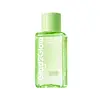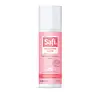What's inside
What's inside
 Key Ingredients
Key Ingredients

 Benefits
Benefits

 Concerns
Concerns

No concerns
 Ingredients Side-by-side
Ingredients Side-by-side

Water
Skin ConditioningHydroxyethyl Urea
HumectantMethylpropanediol
Solvent1,2-Hexanediol
Skin ConditioningPentylene Glycol
Skin ConditioningPolyglycerin-3
HumectantHydroxyacetophenone
AntioxidantBis-PEG-18 Methyl Ether Dimethyl Silane
EmollientCentella Asiatica Leaf Extract
Skin ConditioningCeramide NP
Skin ConditioningButylene Glycol
HumectantHyaluronic Acid
HumectantAllantoin
Skin ConditioningMaltodextrin
AbsorbentAbronia Villosa Leaf Extract
Skin ConditioningSilk Amino Acids
HumectantGentiana Scabra Root Extract
Skin ConditioningSodium Hyaluronate
HumectantMenthol
MaskingCastanea Sativa Seed Extract
Skin ConditioningHelianthus Annuus Seed Extract
Skin ConditioningMenthyl Lactate
MaskingPEG-35 Castor Oil
EmulsifyingGlycine Soja Seed Extract
Skin ConditioningSecale Cereale Seed Extract
AbrasivePyrus Cydonia Seed Extract
MaskingHibiscus Abelmoschus Seed Extract
MaskingPanicum Miliaceum Seed Extract
Skin ConditioningGlycerin
HumectantPEG-40 Hydrogenated Castor Oil
EmulsifyingGlyceryl Polymethacrylate
PPG-26-Buteth-26
Skin ConditioningXanthan Gum
EmulsifyingDisodium EDTA
PEG-50 Hydrogenated Castor Oil
EmulsifyingNonoxynol-14
Propylene Glycol
HumectantBHT
AntioxidantEthylhexylglycerin
Skin ConditioningWater, Hydroxyethyl Urea, Methylpropanediol, 1,2-Hexanediol, Pentylene Glycol, Polyglycerin-3, Hydroxyacetophenone, Bis-PEG-18 Methyl Ether Dimethyl Silane, Centella Asiatica Leaf Extract, Ceramide NP, Butylene Glycol, Hyaluronic Acid, Allantoin, Maltodextrin, Abronia Villosa Leaf Extract, Silk Amino Acids, Gentiana Scabra Root Extract, Sodium Hyaluronate, Menthol, Castanea Sativa Seed Extract, Helianthus Annuus Seed Extract, Menthyl Lactate, PEG-35 Castor Oil, Glycine Soja Seed Extract, Secale Cereale Seed Extract, Pyrus Cydonia Seed Extract, Hibiscus Abelmoschus Seed Extract, Panicum Miliaceum Seed Extract, Glycerin, PEG-40 Hydrogenated Castor Oil, Glyceryl Polymethacrylate, PPG-26-Buteth-26, Xanthan Gum, Disodium EDTA, PEG-50 Hydrogenated Castor Oil, Nonoxynol-14, Propylene Glycol, BHT, Ethylhexylglycerin
Water
Skin ConditioningBetaine
HumectantMethylpropanediol
SolventDipotassium Glycyrrhizate
HumectantGlycerin
HumectantDisodium EDTA
Allantoin
Skin ConditioningNiacinamide
SmoothingSodium Hyaluronate
HumectantBenzophenone-4
UV AbsorberAlpha-Glucan Oligosaccharide
CleansingSodium Hydroxide
BufferingPolymnia Sonchifolia Root Juice
Skin ConditioningAloe Barbadensis Leaf Extract
EmollientMaltodextrin
AbsorbentLactobacillus
Skin ConditioningPhenoxyethanol
PreservativeChlorphenesin
AntimicrobialWater, Betaine, Methylpropanediol, Dipotassium Glycyrrhizate, Glycerin, Disodium EDTA, Allantoin, Niacinamide, Sodium Hyaluronate, Benzophenone-4, Alpha-Glucan Oligosaccharide, Sodium Hydroxide, Polymnia Sonchifolia Root Juice, Aloe Barbadensis Leaf Extract, Maltodextrin, Lactobacillus, Phenoxyethanol, Chlorphenesin
 Reviews
Reviews

Ingredients Explained
These ingredients are found in both products.
Ingredients higher up in an ingredient list are typically present in a larger amount.
Allantoin is a soothing ingredient known for its protective and moisturizingg properties. Because of this, it is often added to products with strong active ingredients.
Studies show higher concentrations of this ingredient can promote wound healing.
Though it can be derived from the comfrey plant, allantoin is produced synthetically for cosmetic products to ensure purity.
Learn more about AllantoinDisodium EDTA plays a role in making products more stable by aiding other preservatives.
It is a chelating agent, meaning it neutralizes metal ions that may be found in a product.
Disodium EDTA is a salt of edetic acid and is found to be safe in cosmetic ingredients.
Learn more about Disodium EDTAGlycerin is already naturally found in your skin. It helps moisturize and protect your skin.
A study from 2016 found glycerin to be more effective as a humectant than AHAs and hyaluronic acid.
As a humectant, it helps the skin stay hydrated by pulling moisture to your skin. The low molecular weight of glycerin allows it to pull moisture into the deeper layers of your skin.
Hydrated skin improves your skin barrier; Your skin barrier helps protect against irritants and bacteria.
Glycerin has also been found to have antimicrobial and antiviral properties. Due to these properties, glycerin is often used in wound and burn treatments.
In cosmetics, glycerin is usually derived from plants such as soybean or palm. However, it can also be sourced from animals, such as tallow or animal fat.
This ingredient is organic, colorless, odorless, and non-toxic.
Glycerin is the name for this ingredient in American English. British English uses Glycerol/Glycerine.
Learn more about GlycerinMaltodextrin is a polysaccharide. It is derived from starch such as rice, corn, wheat, or potato starch.
In food, Maltodextrin is used to improve the texture and thicken a product. Due to its structure, it can help create a gel texture. As an emulsion stabilizer, it helps keep the ingredients in a product together.
As a polysaccharide, Maltodextrin has moisturizing properties. Polysaccharides are a type of carbohydrate. The top layer of skin uses polysaccharides to retain water, keeping the skin hydrated.
Maltodextrin is water soluble and has a sweet taste.
Learn more about MaltodextrinMethylpropanediol is a synthetic solvent and humectant.
As a solvent, it helps dissolve other ingredients, helping to evenly distribute ingredients throughout the product. This ingredient has also been shown to have antimicrobial properties which makes it a preservative booster.
Methylpropanediol is able to add a bit of moisture to the skin. It also helps other ingredients be better absorbed into the skin, such as salicylic acid.
Learn more about MethylpropanediolSodium Hyaluronate is hyaluronic acid's salt form. It is commonly derived from the sodium salt of hyaluronic acid.
Like hyaluronic acid, it is great at holding water and acts as a humectant. This makes it a great skin hydrating ingredient.
Sodium Hyaluronate is naturally occurring in our bodies and is mostly found in eye fluid and joints.
These are some other common types of Hyaluronic Acid:
Learn more about Sodium HyaluronateWater. It's the most common cosmetic ingredient of all. You'll usually see it at the top of ingredient lists, meaning that it makes up the largest part of the product.
So why is it so popular? Water most often acts as a solvent - this means that it helps dissolve other ingredients into the formulation.
You'll also recognize water as that liquid we all need to stay alive. If you see this, drink a glass of water. Stay hydrated!
Learn more about Water